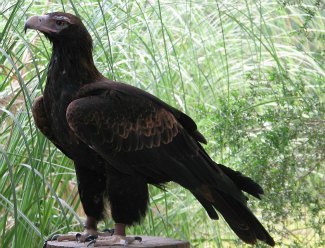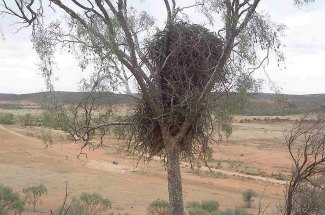Wedge-Tailed Eagle - Aquila audax
By JJ Harrison, CC-BY-SA-3.0, via Wikimedia Commons
Family: Accipitridae
Genus: Aquila
Species: A. audax
Subspecies: A. a. audax, A. a. fleayi (Tasmanian Wedge-Tailed Eagle)
Wedge-Tailed Eagles are some of the largest eagles in the world, with a wingspan of almost three meters. They are endemic to Australia and surrounding islands and live in a range of habitats. They form a clade with A. africana (Cassin's Hawk Eagle), A. chrysaetos (Golden Eagle), A. fasciata (Bonelli's Eagle), A. gurneyi (Gurney's Eagle), and A. verreauxii (Verreaux's Eagle).
Physical Description:
Wedge-Tailed Eagles are entirely black-brown except for rufous to tawny markings along the nape, gray-brown mottling on the greater wing-coverts, and a brown-rufous crissum. They have a gray wing band spanning a quarter of the length of the wing and gray bases along the flight feathers. Subspecies Aquila audax fleayi (Tasmanian Wedge-Tailed eagle) has no rufous plumage on the nape, is lighter in color than the nominate subspecies with occasional gold plumage along the upperwings, and is larger. Both subspecies have a very large, pale pink beak, light brown eyes, and white feet and cere.
Juveniles are dark brown with rufous markings, a streaked head and chest, and a red-brown nape; they are rarely completely black. The eyes are slightly darker than those of adults and the feet are yellower. They reach full adult plumage after 7-8 years.
Wedge-Tailed Eagles are vocal close to the nest and during aerial displays, and their most common call is a thin whistle. Females have a lower and harsher voice than males.
They can live up to at least 40 years in captivity (the eagle that reached 40 died of a bone in its throat, not old age), though the average is 26.4.
By Vicki Nunn, Public domain, via Wikimedia Commons
Size:
Length: 85-106 cm
Wingspan: 182-274 cm
Weight: Male: 2.4-4.0 kg. Female: 3.2-5.3 kg.
Habitat and Distribution:
They occur in a range of habitats including woodland, rainforest, grassland, desert, sub-alpine forest, coniferous forest, and coastal areas. They are usually found 0-2,000 meters above sea level and tend to avoid population centers.
Wedge-Tailed Eagles live from 8°S to 44°S and are endemic to Australia and New Guinea. They are also present in Tasmania, Great Sandy, Flinders, Kangaroo, Melville, and Groote Eylandt. Adults are sedentary or nomadic under drought conditions and juveniles disperse from their breeding areas. In one case, a juvenile was recorded moving 856 km from its nest site. There are an estimated 100,000 individuals over a range of 7,680,000 km².
Diet and Hunting:
They eat mammals, reptiles, birds, and carrion up to 5 kg. Rabbits make up the bulk of their diet, up to 30-70% in some areas, and they hunt other mammalian prey such as wallabies, hares, foxes, goat kids, lambs, echidnas, and bandicoots. Their reptile prey consists of monitor lizards and bearded dragons, and they hunt a range of birds, from crows and cockatoos to ibises and herons.
Most of their prey is taken on the ground or in the tree canopy. They hunt by soaring, quartering an area, still-hunting from a perch, or pulling mammals from tree cavities. They are also kleptoparasites. Cooperative hunting with other Wedge-Tailed Eagles has been observed, and 15 eagles were once observed hunting down a single Red Kangaroo.
Reproduction:
Breeding displays consist of circling, rolls, claw-grappling, steep dives and swoops, and cartwheeling. They are aggressive toward anything in the sky and are known to attack hang-gliders, model airplanes, helicopters, and other aircraft.
The breeding season is from July-December in most of their range, but starts in May in New Guinea and eggs have been recorded in January-February in northern Australia and September in Tasmania. In western Australia breeding may not occur for four years, if food availability and drought conditions do not allow for it. Pairs are monogamous and control territories of about 30-35 km², in which there may be up to three separate nest sites.
By Poyt448 (Peter Woodard), Public domain, via Wikimedia Commons
Wedge-Tailed Eagle nests can be up to 2.8 m across and 4 m deep, though they start out at only 75 cm. Nests grow with repeated use, and some nest sites have been used for over 50 years. They are lined with green vegetation and placed in a tree, on a cliff, or along a hillside 12-30 m above the ground, sometimes as high as 73. 1-4 eggs are laid, usually 1-2, and incubated for 42-48 days. The eggs are white with purple, brown, or rufous marks and are 73-59 mm. Eggs and nestlings are vulnerable to animals such as monitor lizards, which are known predators of them. Fledging takes 70-95 days and the young are dependent on their parents for up to 6 months after that. They are sexually mature after 3 years.
Conservation:
Wedge-Tailed Eagles are widespread throughout Australia, but the population has declined due to shooting, trapping, deliberate poisoning, and habitat destruction, and subspecies A. a. fleayi (Tasmanian Wedge-Tailed Eagle) was classified as Endangered by the Environment Protection and Biodiversity Conservation Act in 1999. The birds are viewed as a threat to sheep, despite the fact studies have shown less than 3% of their diet is sheep and 99% of the sheep they do take is carrion. The species as a whole is currently listed as Least Concern by BirdLife International.
Taxonomy:
Aquila audax used to be classified as part of genus Uroaetus, but molecular sequencing of one nuclear and two mitochondrial genes has shown that A. audax is closely related to other Aquila species and forms a clade with A. africana (Cassin's Hawk Eagle), A. chrysaetos (Golden Eagle), A. fasciata (Bonelli's Eagle), A. gurneyi (Gurney's Eagle), and A. verreauxii (Verreaux's Eagle).
The scientific name Aquila audax means "bold eagle".
By Fir0002/Flagstaffotos, CC-BY-NC-3.0, via Wikimeda Commons
Subspecies:
There are two subspecies: A. a. audax is found in Australia and New Guinea, and A. a. fleayi is found in Tasmania (hence the name Tasmanian Wedge-Tailed Eagle).
Other Names:
Eaglehawk, Mountain Eagle, Orel klínoocasý (Czech), Kilehaleørn (Danish and Norwegian), Kiilsaba-kotkas (Estonian), Wigstaartarend (Dutch), Kiilapyrstökotka (Finnish), Aigle d’Australie (French), Keilschwanzadler (German), Garuda Australia, Rajawali ekor baji (Indonesian), Iolar dingearrach (Irish), Aquila codacuneata (Italian), Onagainuwashi (Japanese), Orzel australijski (Polish), Águila Audaz (Spanish), Kilstjärtörn (Swedish).
Video of a Wedge-Tailed Eagle:
References:
Jones, M. 2006. "Aquila audax" (On-line), Animal Diversity Web. Accessed April 16, 2012 at
http://animaldiversity.ummz.umich.edu/site/accounts/information/Aquila_audax.html
http://www.australiazoo.com.au/our-animals/amazing-animals/birds/?bird=raptors&animal=wedge-tailed_eagle
http://avibase.bsc-eoc.org/species.jsp?avibaseid=5E574D70AC136CC1
BirdLife International (2012) Species factsheet: Aquila audax. Downloaded from http://www.birdlife.org on 16/04/2012.
http://www.birdsinbackyards.net/species/Aquila-audax
Department of Sustainability, Environment, Water, Population and Communities (2012). Aquila audax fleayi in Species Profile and Threats Database, Department
of Sustainability, Environment, Water, Population and Communities, Canberra. Available from:
http://www.environment.gov.au/sprat. Accessed Mon, 16 Apr 2012 22:15:46 +1000.
Global Raptor Information Network. 2012. Species account: Wedge-tailed Eagle Aquila audax. Downloaded from
http://www.globalraptors.org on 16 Apr. 2012
http://ibc.lynxeds.com/species/wedge-tailed-eagle-aquila-audax
BirdLife International 2009. Aquila audax. In: IUCN 2011. IUCN Red List of Threatened Species. Version 2011.2.
www.iucnredlist.org. Downloaded on 16 April 2012.
Ferguson-Lees, James, and Christie, David A. Raptors of the World. Houghton Mifflin Company, 2001.
http://www.raptor.org.au/aaudax.html
http://www.travelling-australia.info/InfsheetsA/Aquila_audax.html



